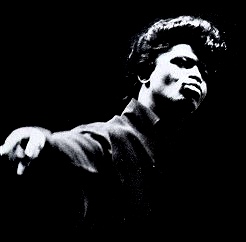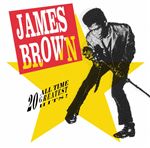Goodbye, Godfather
To those of us who grew up after his artistic heyday, James Brown is some combination of legend, influence, icon, and inevitably, caricature. So on the day we find out about his passing, I thought I’d point out some examples of what an amazing cultural force he was, in the hopes this will help overshadow the endless broadcasts of “Living in America” or other trifles that might otherwise be the most prominent examples of his legacy.

Though one of his best known sobriquets is “The Godfather of Soul”, a more accurate title would have been “The Father of Funk”. James didn’t just popularize the term, he defined the genre as a unique combination of sex, sweat, and social awareness. And it worked, at every level.
How profound was the change? Well, when Martin Luther King was assassinated, cities across the country threatened to explode into riots — New York, Los Angeles and Chicago all had outbreaks of violence. James Brown was in Boston, and convinced the mayor to let him play his scheduled show at the Boston Garden. The show was broadcast on local TV and continued for hours, and is credited with quelling the threat of violence in the city. James Brown stops riots.
Just a short while later, when Richard Nixon was inaugurated, James Brown played the song he’d written in honor of King’s memory, “Say It Loud, I’m Black and I’m Proud”. With Muhammad Ali banned from boxing at the time, and the Tommie Smith and John Carlos black power salute on the Olympic podium still a few months away, it was an astonishingly prominent venue for delivering a message of black pride. Nobody else had the combination of cultural currency and real-world credibility for a move like that.
James Brown was an innovator in the music industry as well. He was the first black artist to own his own master recordings for some of his work, was the first to create side acts and spinoff artists to help capitalize on his success, and was one of the first popular artists to actively court a bidding war between record labels while at the height of his popularity. It’s unlikely we’d have black artists today owning record labels, clothing lines, and producing thier own acts without his influence.
Of course, James Brown’s legacy is a complex one. He was an abuser, of the women in his life as well as himself through various addictions over the years. By contemporary standards, it’s likely that other artists in his act would be credited with songwriting or production, especially given that James didn’t usually play any instruments on his compositions. The breadth of his cultural presence is such that “James Brown is Dead” became a hit song for L.A. Style in 1991, the same year that the career-spanning box set Star Time was released. And the Tom Tom Club single “Genius of Love” is about James Brown. That’s right — you can make a hit song by making a song about James Brown.
So when looking at his legacy, it makes sense to look to the music itself. It’s not an overstatement to say that without James Brown popular music as we know it tonight might well not exist. Besides being a founding father of funk and shepherding many of the best musicians in the genre through his band at various points in his career, his songs and the songs of his side projects formed the first and most widely-used samples for hip hop artists from the very beginning.
(As I write this, The Breaks, the definitive database of music samples, is down, replaced with a simple, appropriate page in memoriam.)
There are so many releases, re-issues, obscure songs in various formats, and sheer volume of records that James Brown has released under his own name and under the names of his band members and partners that it may well be impossible to create a complete archive of all his commercial recordings. The sheer statistics are overwhelming: Over 100 charting singles. Almost as many released albums. And the album version of “Papa Don’t Take No Mess” is a mind-blowing fourteen minutes long.
Brown’s output was wildly uneven, especially later in his career, with all-time classics sandwiched between laughable tracks that were clearly tossed off in the studio. The man was clearly not afraid of embracing any material that he thought might help him reach a new audience — the last time I saw his show, he’d worked in a few bars of “Who Let The Dogs Out” in the midst of a particularly frenetic medley. But the lunacy of his material was irrelevant in a live setting — if James Brown hadn’t named himself “The Hardest Working Man In Show Business”, someone else would inevitably have done it for him.
The live show well be the best place to start with an overview of his recordings.
- Love Power Peace captures the original JBs at the height of their powers. The recording features a single show in Paris in 1971 so famously funky that a French woman stripped down naked and started dancing on a table at the show and nobody moved to stop her. People will tell you to get “Live at the Apollo” — if you don’t have either of the records, get this one instead.
- Star Time. The definitive James Brown box set is also one of the definitive box sets of all time, by any artist. The liner notes alone won a Grammy. But all 71 tracks on the set are astounding. The third disc alone, highlighting a range of 70s funk classics, is essential. By featuring three additional discs of material of that quality, Star Time indispensable.
- Not yet a fan? Try 20 All-Time Greatest Hits distills the best of Star Time into a single disc. You’ll recognize nearly every song on this record, even if you’ve never known that you’ve heard them before, either from being sampled in newer songs or just from the sheer pervasiveness of James Brown’s influence on popular culture.
